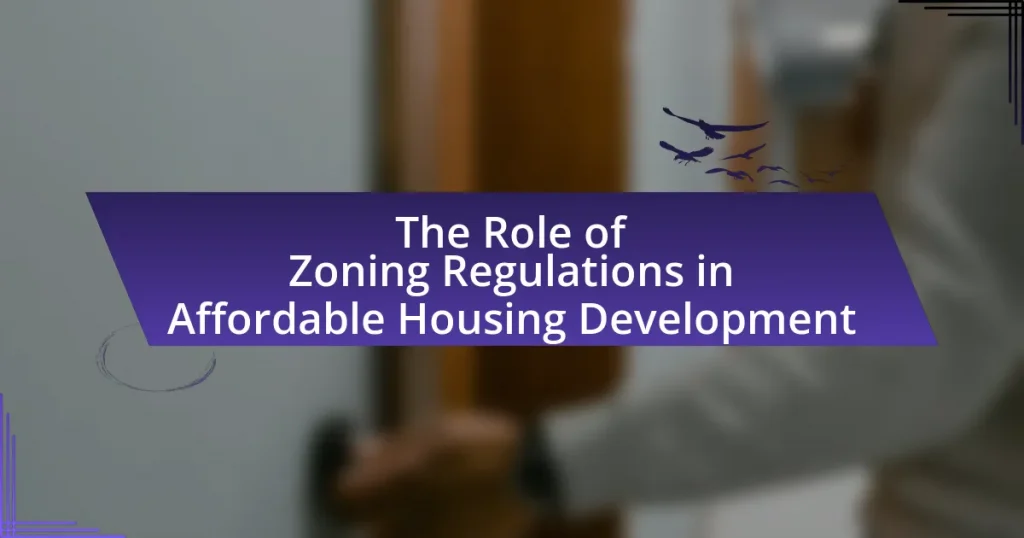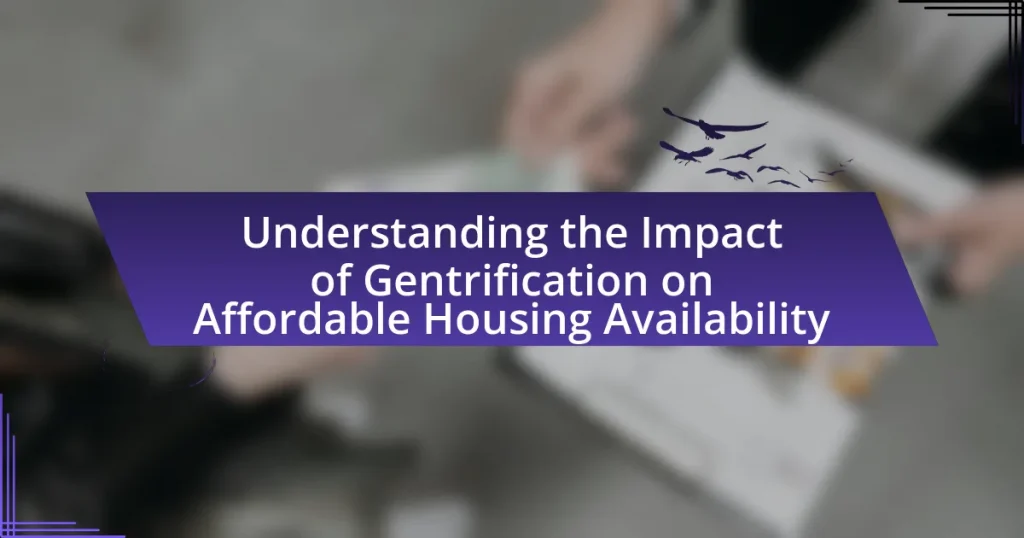The article examines how technology is influencing affordable housing policy frameworks, highlighting the role of data-driven decision-making and efficiency enhancements in housing development. Key technologies such as Geographic Information Systems (GIS), modular construction, and smart home technology are discussed for their impact on resource allocation, project approval speeds, and overall housing affordability. The article also addresses the importance of stakeholder engagement, the challenges faced in technology adoption, and best practices for integrating technology into housing policies. Additionally, it explores the financial implications of adopting new technologies and the significance of community involvement in ensuring successful implementation.

How is Technology Influencing Affordable Housing Policy Frameworks?
Technology is significantly influencing affordable housing policy frameworks by enabling data-driven decision-making and enhancing efficiency in housing development processes. For instance, the use of Geographic Information Systems (GIS) allows policymakers to analyze spatial data, identify areas in need of affordable housing, and allocate resources more effectively. Additionally, platforms that facilitate online applications and streamline permitting processes reduce bureaucratic delays, making it easier for developers to build affordable units. According to a report by the Urban Institute, cities that have adopted technology-driven approaches have seen a 20% increase in the speed of housing project approvals, demonstrating the tangible impact of technology on policy effectiveness.
What role does technology play in shaping housing policies?
Technology plays a crucial role in shaping housing policies by enabling data-driven decision-making and enhancing transparency in the housing market. Advanced analytics and geographic information systems (GIS) allow policymakers to assess housing needs, identify trends, and allocate resources effectively. For instance, cities like San Francisco utilize data platforms to analyze housing availability and affordability, which informs zoning laws and development incentives. Additionally, technology facilitates public engagement through online platforms, allowing citizens to participate in policy discussions and contribute to the decision-making process. This integration of technology not only streamlines policy formulation but also promotes accountability and responsiveness in addressing housing challenges.
How do digital tools enhance policy development in affordable housing?
Digital tools enhance policy development in affordable housing by providing data-driven insights and facilitating stakeholder engagement. These tools, such as geographic information systems (GIS) and data analytics platforms, allow policymakers to analyze housing trends, identify needs, and assess the impact of proposed policies. For instance, a study by the Urban Institute found that data visualization tools can help local governments better understand housing market dynamics, leading to more informed decision-making. Additionally, digital platforms enable collaboration among various stakeholders, including government agencies, non-profits, and community members, ensuring that diverse perspectives are considered in the policy-making process. This collaborative approach ultimately results in more effective and equitable housing policies.
What technologies are most impactful in the affordable housing sector?
The most impactful technologies in the affordable housing sector include modular construction, 3D printing, and smart home technology. Modular construction allows for faster and more cost-effective building processes, reducing labor costs and construction time by up to 50%. 3D printing enables the creation of homes at a fraction of traditional costs, with some projects demonstrating the ability to produce a house in under 24 hours for less than $4,000. Smart home technology enhances energy efficiency and reduces utility costs, making housing more affordable in the long term. These technologies collectively address the pressing need for affordable housing by improving efficiency, reducing costs, and enhancing livability.
Why is it important to integrate technology into housing policies?
Integrating technology into housing policies is crucial for enhancing efficiency, transparency, and accessibility in the housing sector. Technology facilitates data-driven decision-making, allowing policymakers to analyze housing trends and needs more effectively. For instance, the use of Geographic Information Systems (GIS) enables the visualization of housing data, helping to identify areas in need of affordable housing. Additionally, technology can streamline processes such as application submissions and approvals, reducing bureaucratic delays. A study by the Urban Institute found that cities employing technology in housing policy saw a 30% increase in application processing speed, demonstrating the tangible benefits of such integration.
How does technology improve accessibility in affordable housing?
Technology improves accessibility in affordable housing by utilizing smart design tools, data analytics, and digital platforms to enhance the planning, construction, and management processes. For instance, Building Information Modeling (BIM) allows architects and developers to create more efficient designs that accommodate diverse needs, ensuring that housing units are accessible to individuals with disabilities. Additionally, data analytics can identify areas with the highest demand for affordable housing, enabling policymakers to allocate resources effectively. Digital platforms facilitate communication between tenants and housing authorities, streamlining maintenance requests and improving overall living conditions. These technological advancements contribute to creating more inclusive and accessible housing solutions, ultimately supporting the goal of affordable housing for all.
What are the potential risks of not utilizing technology in housing policies?
Not utilizing technology in housing policies can lead to inefficiencies, lack of data-driven decision-making, and increased costs. Without technology, housing authorities may struggle to accurately assess housing needs, resulting in misallocation of resources. For instance, a study by the Urban Institute found that cities using data analytics improved their housing allocation efficiency by 30%. Additionally, the absence of technology can hinder communication and collaboration among stakeholders, delaying project timelines and exacerbating housing shortages. Furthermore, without technological tools, tracking and managing housing developments becomes cumbersome, leading to potential regulatory compliance issues and increased risk of fraud.
What are the current trends in technology and affordable housing?
Current trends in technology and affordable housing include the use of modular construction, smart home technology, and data analytics for urban planning. Modular construction allows for faster and more cost-effective building processes, reducing overall housing costs. Smart home technology enhances energy efficiency and reduces utility expenses, making homes more affordable to maintain. Data analytics is increasingly utilized by city planners to identify housing needs and optimize resource allocation, ensuring that affordable housing developments meet community demands effectively. These trends are supported by industry reports indicating that modular homes can be built up to 50% faster than traditional methods, and smart technologies can lower energy costs by 10-30%.
How are smart technologies being adopted in affordable housing projects?
Smart technologies are being adopted in affordable housing projects through the integration of IoT devices, energy-efficient systems, and data analytics to enhance living conditions and reduce costs. For instance, smart meters and energy management systems help monitor and optimize energy consumption, leading to lower utility bills for residents. Additionally, the use of building management systems allows for real-time monitoring of building performance, which can improve maintenance efficiency and reduce operational costs. According to a report by the Urban Land Institute, incorporating smart technologies in affordable housing can lead to a 20-30% reduction in energy costs, making housing more sustainable and affordable for low-income families.
What innovations are emerging in the construction of affordable housing?
Innovations in the construction of affordable housing include modular construction, 3D printing, and sustainable building materials. Modular construction allows for prefabricated sections to be built off-site and assembled quickly, reducing labor costs and construction time. For instance, a study by the National Institute of Building Sciences found that modular construction can decrease project timelines by up to 50%. 3D printing technology is also emerging, enabling the creation of entire homes in a matter of days, which significantly lowers costs; a notable example is ICON’s 3D-printed homes that can be built for as little as $4,000. Additionally, the use of sustainable materials, such as recycled plastics and bamboo, not only reduces environmental impact but also lowers material costs, making housing more affordable. These innovations collectively address the pressing need for cost-effective housing solutions.

How are Stakeholders Adapting to Technological Changes in Housing Policies?
Stakeholders are adapting to technological changes in housing policies by integrating data analytics, digital platforms, and smart technologies into their decision-making processes. For instance, local governments are utilizing Geographic Information Systems (GIS) to analyze housing trends and identify areas in need of affordable housing, which enhances policy effectiveness. Additionally, non-profit organizations are employing online platforms to streamline applications for housing assistance, making the process more accessible and efficient for applicants. The National Low Income Housing Coalition reported that such technological advancements have led to improved transparency and accountability in housing programs, ultimately fostering better outcomes for communities.
Who are the key stakeholders in affordable housing policy frameworks?
Key stakeholders in affordable housing policy frameworks include government agencies, non-profit organizations, private developers, community groups, and financial institutions. Government agencies, such as local housing authorities, play a crucial role in policy formulation and implementation, while non-profit organizations advocate for low-income populations and provide support services. Private developers are essential for constructing affordable housing units, and community groups ensure that the needs of residents are represented in policy discussions. Financial institutions, including banks and credit unions, provide funding and financing options for affordable housing projects. These stakeholders collectively influence the effectiveness and accessibility of affordable housing initiatives.
What roles do government agencies play in technology adoption for housing?
Government agencies play a crucial role in technology adoption for housing by establishing policies, providing funding, and facilitating partnerships. These agencies create regulatory frameworks that encourage innovation in housing technology, such as smart building systems and energy-efficient designs. For instance, the U.S. Department of Housing and Urban Development (HUD) has initiatives that promote the use of technology to improve housing quality and accessibility. Additionally, government funding programs, like the Low-Income Housing Tax Credit, incentivize developers to incorporate advanced technologies in affordable housing projects. By fostering collaboration between public and private sectors, government agencies help to accelerate the integration of technology in housing, ultimately aiming to enhance living conditions and reduce costs for residents.
How are non-profit organizations leveraging technology in housing initiatives?
Non-profit organizations are leveraging technology in housing initiatives by utilizing data analytics, online platforms, and mobile applications to enhance service delivery and improve access to affordable housing. For instance, organizations like Habitat for Humanity use data analytics to identify areas with the greatest need for housing, allowing them to allocate resources more effectively. Additionally, online platforms facilitate connections between potential homeowners and housing resources, streamlining the application process. Mobile applications enable real-time communication and updates for clients, improving engagement and transparency. These technological advancements not only increase operational efficiency but also empower communities by providing them with the tools needed to navigate housing challenges.
What challenges do stakeholders face in implementing technology?
Stakeholders face several challenges in implementing technology, including resistance to change, lack of technical expertise, and insufficient funding. Resistance to change often stems from established practices and fear of disruption, which can hinder the adoption of new technologies. A study by the McKinsey Global Institute found that organizations that fail to address cultural resistance can see a 70% failure rate in technology initiatives. Additionally, stakeholders may lack the necessary technical skills to effectively utilize new technologies, leading to underutilization or misapplication. Furthermore, budget constraints can limit the ability to invest in advanced technologies, as highlighted by a report from the National Association of Housing and Redevelopment Officials, which indicates that many affordable housing projects struggle to secure adequate funding for technological upgrades. These factors collectively impede the successful implementation of technology in affordable housing policy frameworks.
How can resistance to change be addressed among stakeholders?
Resistance to change among stakeholders can be addressed through effective communication, involvement in the change process, and providing education about the benefits of the change. Engaging stakeholders early in the process fosters a sense of ownership and reduces anxiety about the unknown. Research indicates that organizations that involve stakeholders in decision-making processes experience a 70% higher success rate in implementing change initiatives. Additionally, providing clear, data-driven evidence of the benefits, such as improved efficiency or cost savings, can help alleviate concerns and build support for the change.
What are the financial implications of adopting new technologies?
Adopting new technologies in affordable housing can lead to significant financial implications, including reduced construction costs and improved operational efficiencies. For instance, the use of modular construction techniques can decrease building time by up to 50%, which directly lowers labor costs and accelerates return on investment. Additionally, technologies such as Building Information Modeling (BIM) enhance project planning and resource management, resulting in cost savings of approximately 10-20% on average in construction projects. Furthermore, integrating smart technologies in housing can lead to long-term savings through energy efficiency, with studies indicating that smart homes can reduce energy costs by 10-30%. These financial benefits underscore the importance of technology adoption in shaping effective affordable housing policies.

What Best Practices Can Enhance Technology Integration in Affordable Housing Policies?
Best practices that can enhance technology integration in affordable housing policies include leveraging data analytics for informed decision-making, utilizing digital platforms for stakeholder engagement, and implementing smart building technologies. Data analytics enables policymakers to identify housing needs and trends, as evidenced by the use of geographic information systems (GIS) to map housing shortages in urban areas. Digital platforms facilitate communication between residents, developers, and government agencies, improving transparency and collaboration, as seen in initiatives like participatory budgeting. Smart building technologies, such as energy-efficient systems, reduce operational costs and improve living conditions, which is supported by studies showing that energy-efficient homes can lower utility expenses by up to 30%. These practices collectively foster a more effective and responsive affordable housing policy framework.
How can data analytics improve decision-making in housing policies?
Data analytics can significantly enhance decision-making in housing policies by providing data-driven insights that inform resource allocation and policy effectiveness. By analyzing demographic trends, housing market dynamics, and socio-economic factors, policymakers can identify areas of need, assess the impact of existing policies, and forecast future housing demands. For instance, a study by the Urban Institute found that data analytics can help local governments optimize zoning laws and housing development strategies, leading to more efficient use of land and resources. This evidence demonstrates that leveraging data analytics not only improves the precision of policy decisions but also fosters more equitable housing solutions.
What types of data are most valuable for affordable housing policy frameworks?
The most valuable types of data for affordable housing policy frameworks include demographic data, housing market data, and economic indicators. Demographic data, such as population growth, income levels, and household composition, helps policymakers understand the needs of different communities. Housing market data, including rental prices, vacancy rates, and housing stock availability, provides insights into supply and demand dynamics. Economic indicators, such as employment rates and wage growth, inform the affordability of housing options. Collectively, these data types enable the development of targeted policies that address specific housing challenges, as evidenced by studies showing that data-driven approaches lead to more effective housing solutions.
How can data privacy concerns be managed in housing technology?
Data privacy concerns in housing technology can be managed through robust data governance frameworks, including encryption, access controls, and compliance with regulations such as GDPR. Implementing encryption ensures that sensitive data is protected during transmission and storage, while access controls limit data access to authorized personnel only. Compliance with regulations like GDPR mandates transparency in data collection and processing, thereby enhancing user trust. According to a report by the International Association of Privacy Professionals, organizations that prioritize data privacy can reduce the risk of data breaches by up to 50%, demonstrating the effectiveness of these strategies in safeguarding personal information in housing technology.
What strategies can be employed to foster collaboration among stakeholders?
To foster collaboration among stakeholders in affordable housing policy frameworks, strategies such as establishing clear communication channels, creating shared goals, and utilizing collaborative technology platforms can be employed. Clear communication channels ensure that all stakeholders are informed and engaged, which is crucial for building trust and understanding. Creating shared goals aligns the interests of diverse stakeholders, facilitating a unified approach to problem-solving. Collaborative technology platforms, such as project management tools and online forums, enhance coordination and information sharing, enabling stakeholders to work together more effectively. These strategies have been shown to improve stakeholder engagement and project outcomes in various sectors, including housing development initiatives.
How can public-private partnerships enhance technology use in housing?
Public-private partnerships can enhance technology use in housing by facilitating investment in innovative building methods and smart housing solutions. These collaborations leverage the strengths of both sectors; public entities provide regulatory support and funding, while private companies contribute technological expertise and efficiency. For instance, a study by the Urban Institute highlights that such partnerships have led to the implementation of advanced construction technologies, like modular building and energy-efficient systems, which reduce costs and improve sustainability in housing projects. This synergy not only accelerates the adoption of new technologies but also ensures that housing solutions are more responsive to community needs and environmental challenges.
What role does community engagement play in technology adoption?
Community engagement is crucial in technology adoption as it fosters trust, enhances user acceptance, and ensures that technological solutions meet the actual needs of the community. Engaging community members in the development and implementation phases allows for feedback that can lead to more effective and tailored technology solutions. For instance, studies have shown that projects involving community input are 30% more likely to succeed in achieving their intended outcomes, as they align closely with user expectations and local contexts. This participatory approach not only increases the likelihood of adoption but also promotes a sense of ownership among community members, further driving the successful integration of technology into everyday practices.
What practical steps can be taken to implement technology in affordable housing?
To implement technology in affordable housing, stakeholders should focus on integrating smart building technologies, utilizing data analytics for resource management, and adopting modular construction techniques. Smart building technologies, such as energy-efficient systems and IoT devices, can significantly reduce operational costs and enhance living conditions. Data analytics can optimize resource allocation and maintenance schedules, leading to improved efficiency and reduced waste. Modular construction techniques allow for faster and more cost-effective building processes, which can lower overall housing costs. According to a report by McKinsey & Company, the construction industry could see productivity gains of up to 15% through the adoption of these technologies, demonstrating their potential impact on affordable housing initiatives.
How can pilot programs be effectively utilized to test new technologies?
Pilot programs can be effectively utilized to test new technologies by implementing small-scale trials that allow for controlled experimentation and data collection. These programs enable stakeholders to assess the feasibility, effectiveness, and scalability of innovative solutions in real-world settings, minimizing risks associated with broader deployment. For instance, the U.S. Department of Housing and Urban Development has employed pilot programs to evaluate technology-driven approaches in affordable housing, demonstrating their potential to improve efficiency and reduce costs. By analyzing outcomes from these trials, policymakers can make informed decisions about adopting new technologies on a larger scale, ensuring that investments are based on empirical evidence rather than assumptions.
What resources are available for stakeholders to learn about technology integration?
Stakeholders can access various resources to learn about technology integration, including online courses, webinars, and industry reports. Online platforms like Coursera and edX offer courses specifically focused on technology integration in housing and urban development. Webinars hosted by organizations such as the National Association of Housing and Redevelopment Officials provide insights from experts in the field. Additionally, reports from the Urban Institute and the Joint Center for Housing Studies of Harvard University offer data-driven analysis and case studies on the impact of technology in affordable housing. These resources collectively equip stakeholders with the knowledge and skills necessary for effective technology integration in housing policy frameworks.



